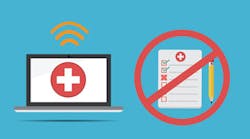Why electronic health records need to be integrated into dentistry
Health-care disciplines are increasingly recognizing that preventive oral health care and maintenance is critical when assessing an individual’s overall wellness. Oral inflammation has a direct influence on a multitude of systemic conditions, so there’s no disputing that dental hygienists are integral members of a patient’s comprehensive health-care team.
Clinical practice that once involved scaling and root planing for all diseased patients is now being joined with salivary diagnostics, which is pH and nitric oxide testing that yields results specific to a patient’s health and genetics. However, if the standard of oral health care is to be elevated, and dental hygienists are to truly be members of a patient’s comprehensive health-care team, then we must change the way we communicate with providers outside the dental setting.
Electronic health records (EHRs) are a documentation system in medicine that allows providers to easily communicate about patient care within their professional community. Whether it’s sending a quick message, attaching labs or radiographs, reviewing changes in medications, or viewing when the patient was seen by a provider, EHRs create a seamless space for this to occur.
Yet, dentistry still uses our own stand-alone software program and we’re left updating our own medical histories, inputting vital signs for the visit, and creating our own documentation, irrespective of the rest of the medical team. Having a community of providers that collaborates and consults with one another ultimately elevates the standard of patient care. How can EHRs be integrated into dentistry?
Efficacy of EHRs
EHRs have historically been used in medicine to retain patients’ health information, which includes their social history, medical history, medications, vital signs, lab panels, radiology results, and notes from physicians or nurses.1 Complete and accurate EHRs are critical to assessing a patient’s health history and to help reduce accidents in patient care.
EHRs have been combining health-related information from various disciplines for years, which facilitates better communication between patients and multiple medical providers.1,2 Many EHR users have attributed this documentation system to improved workflow, enhanced productivity, efficiency, and a reduced number of errors by providers and staff.1,3,4
Not only do EHRs allow providers to document specifics regarding patients’ medical care, but they also provide a space to monitor trends in infectious diseases and identify social determinants of health.2,3The conditions in which patients live, where they work, and how they access health care can drastically impact the delivery of care, which is a significant aspect of individualizing treatment. This type of medical recording system goes far beyond documenting visits and medications and allows providers to understand the demographics in the area where they provide care.3
EHRs eliminate the need for patients to recall their medical histories when seeking care with a new provider.1,2,5 This system collects all information so that providers can easily communicate, and patients do not have to serve as middlemen about their health record. The efficiency and accuracy of this level of patient care should be the standard across health-care disciplines, however, the stand-alone dental software that most practices use segregates dental from medicine.2
As dentistry produces more research reflecting the evidence behind the oral-systemic connection, it seems obvious that medical and dental integration should become more commonplace. Communication between providers is a critical component of interprofessional collaboration, which could lead to improved patient outcomes.2
Although EHRs can provide up-to-date medical knowledge and can monitor a provider’s performance and quality of care, there are limitations with this system.1 Some of the biggest challenges when integrating new software are cost and not having adequate training and evaluations for competency.5 Incorporating more education on EHRs in school curriculums could help facilitate a smoother transition into the workplace and set the precedence for interprofessional collaboration in academia. It also supports providers so they can comfortably, safely, and efficiently use EHRs.4 This is a trend that health care is gradually recognizing as dentistry moves toward a model that understands whole body health.
EHRs in dental
Stand-alone dental software is still commonplace in small dental settings, while EHRs are used more in large organizations such as federally qualified health centers (FQHC).5 Dental settings typically rely on patients to complete a health history form prior to establishing care, which should be updated at each visit.
With EHRs not being as comprehensive as the medical history taken in a medical setting, there’s the risk that some critical information could be left out if a patient forgets or chooses not to disclose certain information.2 One study conducted an interview of caretakers and asked questions regarding their child’s medical history. Results indicated that 53% of parents were not able to provide the child’s specific medical diagnosis and 29% could not list the child’s medications.2
If dental professionals are aware of the oral-systemic link and strive for prevention and maintenance of patients’ oral health, how is this to be achieved if the provider does not have a clear picture of patients’ systemic conditions? Patients are not always aware of the oral-systemic connection, so it’s the responsibly of the oral health-care provider to have accurate records of a patient’s condition(s) so that patient care quality is not compromised.2
EHRs in dentistry have the potential to dismantle stand-alone dental records and promote a health-care delivery system where providers in many disciplines can easily communicate.2 There will be more research on the oral-systemic connection, and more information will contribute to the body of dental knowledge. However, until the communication barrier between health-care providers is disseminated, achieving true oral-systemic health will remain challenging. Working as a team member for the overall health and wellness of patients is a multidisciplinary approach and is not the responsibility of just one provider; rather, it’s the responsibility of the entire health-care team comprised of a number of specialties.2
What does it all mean?
Implementing this system will be met with resistance to change, and the strategy used to adequately train and monitor for competency will be critical.2,3,4 EHRs make it easy to share information between providers and eliminate the risk of adverse health outcomes as a result of not having all necessary patient information. Incorporating this training into dental and medical school curriculum could help facilitate oral-systemic care provided to patients before students enter the workforce.3,4
If students are educated about this, this could ultimately help move the standard of health-care delivery and documentation toward interprofessional collaboration. Oral health-care providers could have a better understanding of not only a patient’s medical history, but their social determinants of health and other pertinent information that could be influencing how they access or receive dental care.
References
1. Campanella P, Lovato E, Marone C, et al. The impact of electronic health records on healthcare quality: a systematic review and meta-analysis. Eur J Public Health. 2015; 26(1):60-64.
2. Claman DB, Molina JL, Peng J, et al. Accuracy of parental self-report of medical history in a dental setting: integrated electronic health record and nonintegrated dental record. Pediatr Dent. 2021;43(3):230-236.
3. Kruse CS, Stein A, Thomas H, et al. The use of electronic health records to support population health: a systematic review of the literature. J Med Syst. 2018;42:1-16.
4. Puranik C, Slavik A, Pickett K, et al. Development of integrated electronic medical and dental record competencies and impact of training modalities. J Dent Educ. 2023;87:660-668.
5. Alanazi A, Alghamdi G, Aldosari B. Information needs for dental-oriented electronic health records from dentists’ perspectives. Healthcare. 2023;11:2-11.
Annie Walters, MSDH, RDH, attended Northern Arizona University, where she spent time caring for individuals in Guatemala and Indian Health Service. She has a special interest in advancing access to care for individuals with specialized health-care needs. She’s a member of ADHA, and received her MS from the University of New Mexico, where she developed a chairside resource for RDHs to use for patients with specialized needs. She practices in Flagstaff, Arizona, and serves as part-time faculty at her alma mater. Contact her at [email protected].









